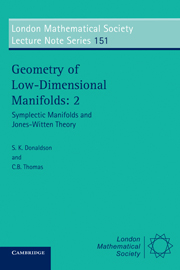Book contents
- Frontmatter
- Contents
- Contributors
- Names of Participants
- Introduction
- Acknowledgements
- PART 1 SYMPLECTIC GEOMETRY
- PART 2 JONES/WITTEN THEORY
- PART 3 THREE-DIMENSIONAL MANIFOLDS
- Introduction
- An introduction to polyhedral metrics of non-positive curvature on 3-manifolds
- Finite groups of hyperbolic isometries
Finite groups of hyperbolic isometries
Published online by Cambridge University Press: 01 June 2011
- Frontmatter
- Contents
- Contributors
- Names of Participants
- Introduction
- Acknowledgements
- PART 1 SYMPLECTIC GEOMETRY
- PART 2 JONES/WITTEN THEORY
- PART 3 THREE-DIMENSIONAL MANIFOLDS
- Introduction
- An introduction to polyhedral metrics of non-positive curvature on 3-manifolds
- Finite groups of hyperbolic isometries
Summary
INTRODUCTION
Our starting point is the theorem of Hurwitz, which gives the bound 84(g - 1) for the group of orientation preserving hyperbolic isometries of a closed surface of genus ≥ 2. In section 2 we will sketch a proof of this result in terms of hyperbolic tesselations, since this is the method which seems most apt for generalising to higher dimensions. It is also clear that one should define a Hurwitz group to be a finite group G for which there exists a closed Riemann surface Sg with the property that ∣I+(Sg)∣ = ∣G∣ = 84(g - 1). And since any Hurwitz group G maps onto a non-abelian simple Hurwitz group G/K, it is an interesting question to ask which of the now-classified simple groups satisfies the Hurwitz condition. For example, among the 26 sporadic groups, 11 are definitely Hurwitz, 13 are not, and for the remaining 2 groups the question has yet to be answered. The two exceptions are G equal to the Baby Monster B or the Monster M, and for the latter the problem reduces to finding the smallest value of c such that M is a homomorphic image of the triangle group T(2,3,c). The best value known to me at the time of writing is c = 29.
It is natural to ask if there are analogous results in dimension 3, given that, if M3 is hyperbolic, then I(M3) is finite, and has order closely related to the volume, which in turn belongs to a well-ordered subset of the real numbers R.
- Type
- Chapter
- Information
- Geometry of Low-Dimensional ManifoldsSymplectic Manifolds and Jones-Witten Theory, pp. 163 - 176Publisher: Cambridge University PressPrint publication year: 1991

